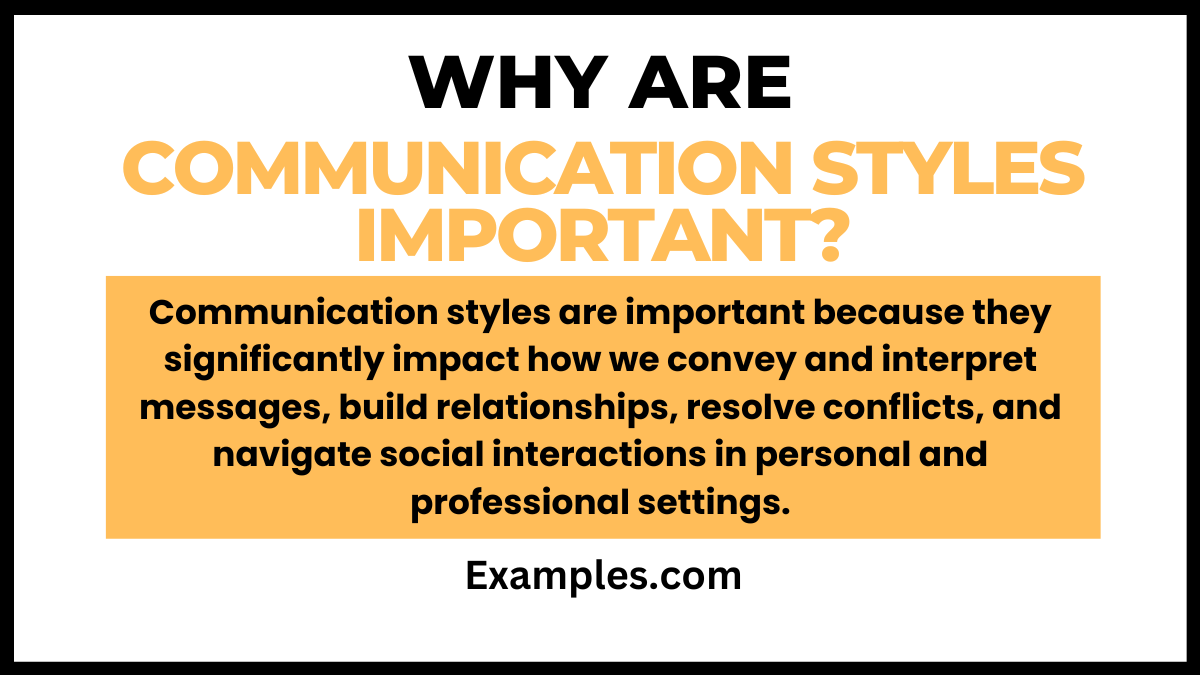10 Types of Communication Styles
Understanding various Types of Communication Styles is crucial for effective interaction in both personal and professional settings. This comprehensive guide explores different communication styles, each illustrated with practical communication examples. From passive to assertive, each style has unique characteristics and impacts how we convey and interpret messages. By delving into these styles, you’ll gain insights into how to adapt your communication approach for more meaningful and successful interactions, enhancing your ability to connect and collaborate with others.
Download Types of Communication Styles in PDFWhy are Communication Styles Important?

Communication Styles are essential because they define how we express ourselves and interact with others. Different styles, like assertive, passive, or aggressive, greatly influence the effectiveness of our communication in various contexts, including personal relationships and communication in the workplace. Understanding and adapting these styles can lead to more successful interactions, as they help us to convey our messages more clearly, resolve conflicts, build stronger relationships, and work more effectively with others. Knowing the right style to use in a given situation is key to effective communication.
10 Types of Communication Styles
Exploring the various Types of Communication Styles is key to understanding and improving how we interact with others. Each style has its unique approach and impact on interpersonal dynamics. From Assertive to Analytical, knowing these styles enhances our ability to navigate different social and professional situations effectively. This guide delves into each style, providing insights into their characteristics and applications, essential for anyone looking to refine their communication skills and build stronger relationships.
Assertive Communication Style
Assertive Communication Style is about expressing oneself openly and honestly while respecting others. It involves clear, direct language and confidence in stating needs and opinions. This style is effective in ensuring mutual respect and understanding in interactions.
Passive Communication Style
Passive Communication Style is characterized by a tendency to avoid expressing opinions or needs directly. Individuals using this style often prioritize others’ needs over their own, which can lead to misunderstandings and resentment in relationships.
Aggressive Communication Style
Aggressive Communication Style involves expressing oneself in a forceful and often confrontational manner. This style can be overwhelming and intimidating, potentially leading to conflicts and strained relationships.
Passive-Aggressive Communication Style
Passive-Aggressive Communication Style is marked by indirect expression of negative feelings or resentment. It combines passive and aggressive elements, often resulting in sarcasm, denial, or avoidance, which can hinder effective communication.
Manipulative Communication Style
Manipulative Communication Style involves influencing or controlling others subtly or indirectly. This style can be deceptive, as the communicator’s true intentions are often hidden, leading to mistrust and confusion.
Open Communication Style
Open Communication Style is characterized by transparency, honesty, and willingness to share thoughts and feelings. It fosters trust and clarity in interactions, making it ideal for building strong, healthy relationships.
Reflective Communication Style
Reflective Communication Style focuses on active listening and empathy. It involves understanding the speaker’s perspective and reflecting their feelings and thoughts, which enhances mutual understanding and connection.
Casual Communication Style
Casual Communication Style is informal and relaxed, commonly used in everyday conversations. It’s characterized by the use of colloquial language and a personal tone, making interactions more comfortable and relatable.
Analytical Communication Style
Analytical Communication Style is characterized by a focus on data, facts, and logical reasoning. It’s often used in situations requiring detail-oriented and evidence-based discussions, ideal for technical or complex topics.
Directive Communication Style
Directive Communication Style is straightforward and task-oriented. It involves giving clear instructions or directions, making it effective in situations where quick decision-making or immediate action is needed.
Are the Communication Styles Exclusive?
Communication styles are not exclusive; individuals often blend different styles based on context, audience, and personal preferences, creating a unique communication approach.
Which Communication Style is Best for the Workplace?
In the workplace, the Assertive Communication Style is often most effective, as it balances clear, respectful expression of ideas with consideration for others’ perspectives.
How Do You Describe Communication Style?
A communication style is described by how individuals express their thoughts and feelings, including their choice of words, tone, body language, and their approach to listening and responding.
Understanding the various Types of Communication Styles is vital for effective personal and professional interactions. Each style, from Assertive to Directive, plays a unique role in shaping our communication, influencing how messages are conveyed and received. Mastering these styles enhances our ability to adapt to different situations, leading to more successful and meaningful exchanges. Embracing the diversity of these communication styles not only enriches our interactions but also contributes to our overall communication competence.
For further insights into effective communication techniques and strategies, resources such as MindTools and Verywell Mind offer valuable information and practical tips. These platforms provide in-depth knowledge that can help individuals refine their communication skills, catering to both personal growth and professional advancement.



